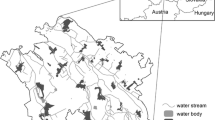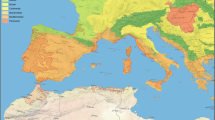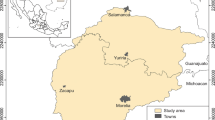Abstract
Temporal and spatial vegetation structure has impact on biodiversity qualities. Yet, current schemes of biotope mapping do only to a limited extend incorporate these factors in the mapping. The purpose of this study is to evaluate the application of a modified biotope mapping scheme that includes temporal and spatial vegetation structure. A refined scheme was developed based on a biotope classification, and applied to a green structure system in Helsingborg city in southern Sweden. It includes four parameters of vegetation structure: continuity of forest cover, age of dominant trees, horizontal structure, and vertical structure. The major green structure sites were determined by interpretation of panchromatic aerial photographs assisted with a field survey. A set of biotope maps was constructed on the basis of each level of modified classification. An evaluation of the scheme included two aspects in particular: comparison of species richness between long-continuity and short-continuity forests based on identification of woodland continuity using ancient woodland indicators (AWI) species and related historical documents, and spatial distribution of animals in the green space in relation to vegetation structure. The results indicate that (1) the relationship between forest continuity: according to verification of historical documents, the richness of AWI species was higher in long-continuity forests; Simpson’s diversity was significantly different between long- and short-continuity forests; the total species richness and Shannon’s diversity were much higher in long-continuity forests shown a very significant difference. (2) The spatial vegetation structure and age of stands influence the richness and abundance of the avian fauna and rabbits, and distance to the nearest tree and shrub was a strong determinant of presence for these animal groups. It is concluded that continuity of forest cover, age of dominant trees, horizontal and vertical structures of vegetation should now be included in urban biotope classifications.






Similar content being viewed by others
References
Atallah YC, Jones CE, Boecker R (2007) Vegetation structure and biodiversity in Mediterranean ecosystems: a comparative study from Lebanon and California. The ESA/SER Joint Meeting, pp 72–48
Attwel K, Malbert B, Lindolm G (2002) Innovative solution from Denmark and Sweden to the design, management and maintenance of urban green spaces. COST C 11-WG1B, Progress Report 2002
Austrheim G, Olsson EGA (1999) How does continuity in grassland management after ploughing affect plant community patterns? Plant Ecology 145:59–74
Bossuyt B, Hermy M, Deckers J (1999) Migration of herbaceous plant species across ancient-recent forest ecotones in central Belgium. Journal of Ecology 87:628–638
Brunet J (1994) Der einfluss von waldnutzung und waldgeschichte auf die vegetation südschwedischer laubwälder. Norddeutsche Naturschutzakademie-Berichte 7:96–101
Brunet J, von Oheimb G (1998) Colonization of secondary woodlands by Anemone nemorosa. Nordic Journal of Botany 18:369–377
Brunet J, von Oheimb G, Diekmann M (2000) Factors influencing vegetation gradients across ancient-recent woodland borderlines in southern Sweden. Journal of Vegetation Science 11:515–524
Cousins SAO, Eriksson O (2002) The influence of management history and habitat on plant species richness in a rural hemiboreal landscape, Sweden. Landscape Ecology 17:517–529
Cousins SAO, Ihse M (1998) A methodological study for biotope and landscape mapping based on CIR aerial photographs. Landscape and Urban Planning 41:183–192
Esseen PA, Hedenås H, Ericson L (1999) Epifytiska lavar som mångfaldsindikatorer. Skog & Forskning 199:40–45
Freeman C, Buck O (2003) Development of an ecological mapping methodology for urban areas in New Zealand. Landscape and Urban Planning 63:161–173
Fujita A, Maeto K, Kagawa Y, Ito N (2008) Effects of forest fragmentation on species richness and composition of ground beetles (Coleoptera: Carabidae and Brachinidae) in urban landscapes. Entomological Science 11:39–48
Gustavsson R (2004) Exploring woodland design: designing with complexity and dynamics-woodland types, their dynamic architecture and establishment. In: Dunnett N, Hitchmough J (eds) The dynamic landscape. Spon Press, New York, pp 184–214
Gustavsson R, Ingelög T (1994) Det Nya landskapet. Skogsstyrelsen, Jönköping, Sweden (in Swedish)
Gyllin M, Hammer M (2004) Approaches to urban biodiversity mapping–methodological considerations. Acta Universitatis Agriculture Sueciae Agraria 461:1–10
Holmes RT, Robinson SK (1988) Spatial patterns, foraging tactics, and diets of ground-foraging birds in a northern hardwood forest. Wilson Bulletin 100:377–394
Hong SK, Song IJ, Byun B, Yoo S, Nakagoshi N (2005) Application of biotope mapping for spatial environmental planning and policy: case studies in urban ecosystems in Korea. Landscape and Ecological Engineering 1:101–112
Hunter ML (1990) Wildlife, forests, and forestry, principles of managing forests for biological diversity. Prentice-Hall, New Jersey, pp 187–199
Jarvis PJ, Young CH (2005) The mapping of urban habitat and its evaluation. A discussion paper prepared for the Urban Forum of the United Kingdom Man and the Biosphere Program. School of Applied Sciences, University of Wolverhampton, West Midlands
Johnson RJ, Beck MM (1988) Planning for avian wildlife in urbanizing areas in American desert/ mountain valley environments. Landscape and Urban Planning 16:245–252
Karr JR, Roth RR (1971) Vegetation structure and avian diversity in several new world areas. The American Naturalist 105:423–435
Kirby K, Goldberg E (2002) Ancient woodland: guidance material for local authorities. English Nature, Peterborough
Koerner W, Dupouey JL, Dambrine E, Benoit M (1997) Influence of past land use on the vegetation and soils of present day forest in the Vosges mountains, France. Journal of Ecology 85:351–358
Kull K, Zobel M (1991) High species richness in an Estonian wooded meadow. Journal of Vegetation Science 2:711–714
Law BS, Dickman CR (1998) The use of habitat mosaics by terrestrial vertebrate fauna: implications for conservation and management. Biodiversity Conservation 7:323–333
Löfvenhaft K, Björn C, Ihse M (2002) Biotope patterns in urban areas: a conceptual model integrating biodiversity issues in spatial planning. Landscape and Urban Planning 58:223–240
McDonald DB, Potts WK, Fitzpatrick JW, Woolfenden GE (1999) Contrasting genetic structures in sister species of North American scrub-jays. Proceedings of the Royal Society B: Biological Sciences 266:1117–1125
McGarigal K, McComb WC (1995) Relationships between landscape structure and breeding birds in the Oregon coast range. Ecological Monographs 65:235–260
Meyer JS, Irwin LL, Boyce MS (1998) Influence of habitat abundance and fragmentation on northern spotted owls in western Oregon. Wildlife Monographs 139:1–51
National Land Survey of Sweden (NLS) (2004) GSD-Topographic Map, Ref: L 1999/139
Nilsson SG, Baranowski R (1993) Species composition of wood beetles in an unmanaged mixed forest in relation to forest history. Entomologiskt Tidskrift 114:133–146
Nilsson SG, Arup U, Baranowski R, Ekman S (1995) Lichens and beetles as indicators in conservation forests. Conservation Biology 9:1208–1215
Nilsson SG, Hedin J, Niklasson M (2001) Biodiversity and its assessment in boreal and nemoral forests. Scandinavian Journal of Forest Research 16:10–26
Penland S (1987) Attitudes of urban residents toward avian species and species’ attributes. In: Adams LW, Leedy DL (eds) Integrating man and nature in the metropolitan environment: proceedings of a National Symposium on Urban Wildlife. Chevy Chase, Columbia, pp 77–82
Peterken G (1974) A method for assessing woodland flora for conservation using indicator species. Biological Conservation 6:239–245
Peterken G (2000) Identifying ancient woodland using vascular plant indicators. British Wildlife 11:153–158
Ralph CJ, Geupel GR, Pyle P, Martin TE, Desante DF (1993) Handbook of field methods for monitoring landbirds. US Forest Service General Technical Report PSW-GTR-44
Reumer JWF, Epe MJ (1999) Biotope mapping in Rotterdam: the background of a project. Biotope Mapping in the Urban Environment, Deinsea 5:1–8
Rolstad J, Gjerde I, Gundersen VS, Saetersdal M (2002) Use of indicator species to assess forest continuity: a critique. Conservation Biology 16:253–257
Rose F (1976) Lichenological indicators of age and environmental continuity in woodland. In: Brown DH, Hawksworth DL, Bayley RH (eds) Lichenology: progress and problems. Academic Press, London, pp 279–307
Rose F (1999) Indicators of ancient woodland: the use of vascular plants in evaluating ancient woods for nature conservation. British Wildlife 10:241–251
Rotenberry JT, Wiens JA (1998) Foraging patch selection by shrubsteppe sparrows. Ecology 79:1160–1173
Rundlöf U, Nilsson SG (1995) Fem Ess metoden. Spåra skyddsvärd skog i södra Sverige. Naturskyddsföreningen, Stockholm, ISBN 91-558-0291-5
Sallabanks R, Haufler JB, Mehl CA (2006) Influence of forest vegetation structure on avian community composition in west-central Idaho. Wildlife Society Bulletin 34:1079–1093
Sanchez-Lafuente AM, Valera F, Godino A, Muela F (2001) Natural and human-mediated factors in the recovery and subsequent expansion of the Purple swamphen Porphyrio L. (Rallidae) in the Iberian Peninsula. Biodiversity and Conservation 10:851–867
Sauer JR, Peterjohn BG, Link WA (1994) Observer differences in the North American breeding bird survey. Auk 111:50–62
Segestrom U, Bradshaw R, Hornberg G, Bohlin E (1994) Disturbance history of a swamp forest refuge in Northern Sweden. Biological Conservation 68:189–196
Selva SB (1994) Lichen diversity and stand continuity in the northern hardwoods and spruce-fir forests of Northern New England and Western New Brunswick. Bryologist 97:424–429
Sjöbeck M (1930/1960) Avritningar av bl a lantmäterihandlingar 1700-talet för Luggude härad. Stadsbyggnadsförvaltningen, Helsingborg
Sukopp H, Weiler S (1988) Biotope mapping and nature conservation strategies in urban areas of the Federal Republic of Germany. Landscape and Urban Planning 15:39–58
Sukopp H, Kunick W, Schneider C (1980) Biotope mapping in the built-up areas of West Berlin. Part 2, Field methods and evaluation. Garten Landschaft 7:565–569
Summary-öp (2002) Comprehensive plan for Helsingborg. Kartunderlag and Geodatacenter, Skåne AB. Översiktsplan för Helsingborgs stad, öp 2002
Tarsitano E (2006) Interaction between the environment and animals in urban settings: integrated and participatory planning. Environmental Management 38:799–809
Trzcinski MK, Fahrig L, Merriam G (1999) Independent effects of forest cover and fragmentation on the distribution of forest breeding birds. Ecological Applications 9:586–593
Tscharntke T, Steffan-Dewenter I, Kruess A, Thies C (2002) Contribution of small habitat fragments to conservation of insect communities of grassland-cropland landscapes. Ecological Applications 12:354–363
Wirén M (1994) Fauna och vegetation I stadens parker. The National Swedish Council of Building Research, report No. 28, pp 155
Wirén M (1995) The relationship between fauna and horizontal vegetation structure in urban parks. In: XVIIth IFPRA World Congress, Ecological Aspects of Green Areas in Urban Environments 5: 25–29
Young CH, Jarvis PJ (2003) Assessing the structural heterogeneity of urban areas: an example from the Black Country (UK). Urban Ecosystems 5:49–69
Zaviezo T, Grez AA, Estades CF, Perez A (2006) Effects of habitat loss, habitat fragmentation, and isolation on the density, species richness, and distribution of ladybeetles in manipulated alfalfa landscapes. Ecological Entomology 31:646–656
Zehm A, Nobis M, Schwabe A (2003) Multiparameter analysis of vertical vegetation structure based on digital image processing. Flora 198:142–160
Acknowledgments
This research was funded by the China Scholarship Council (Chinese government scholarship for postgraduate program) and the Swedish University of Agricultural Sciences postgraduate program. We are grateful to Associate Professor Anders Busse Nielsen for valuable and helpful suggestions on the manuscript. We also appreciate the thorough review and critical comments of the anonymous reviewers that helped improve this manuscript.
Author information
Authors and Affiliations
Corresponding author
Appendix
Appendix
Count, Area and Ratio of Modified Biotope Type in Helsingborg, Sweden
Modified biotope type | Count | Area (1,000 m2) | Ratio (%) |
|---|---|---|---|
Green space | |||
Open green areas <10% tree/shrub | (16.5) | ||
with lawn areas | 14 | 141 | 3.1 |
with grazed land areas | 4 | 179 | 3.9 |
with meadow areas | 12 | 193 | 4.2 |
with succession areas | 5 | 242 | 5.3 |
Partly-open green area 10–30% tree/shrub | (25.2) | ||
with lawn areas | 20 | 843 | 18.5 |
with meadow areas | 8 | 305 | 6.7 |
Partly-closed green area 30–60% tree/shrub | (2.8) | ||
30–80 year of two-layered deciduous | 1 | 13 | 0.3 |
30–80 year of multi-layered deciduous | 1 | 59 | 1.2 |
>80 year of multi-layered mixed | 1 | 61 | 1.3 |
Grove, clump of trees, thicket, tree belt or avenue | (12.2) | ||
<30 year of one-layered deciduous | 31 | 87 | 1.9 |
<30 year of two-layered deciduous | 23 | 189 | 4.1 |
<30 year of multi-layered deciduous | 9 | 192 | 4.2 |
<30 year of one-layered swamp | 3 | 5 | 0.1 |
30–80 year of one-layered deciduous | 2 | 5 | 0.1 |
30–80 year of two-layered deciduous | 6 | 25 | 0.6 |
30–80 year of multi-layered deciduous | 5 | 53 | 1.2 |
Forest | (43.3) | ||
<30 year of one-layered deciduous | 4 | 247 | 5.4 |
<30 year of two-layered deciduous | 1 | 8 | 0.2 |
<30 year of multi-layered deciduous | 7 | 655 | 14.4 |
30–80 year of one-layered conifer | 8 | 118 | 2.6 |
30–80 year of one-layered deciduous | 4 | 9 | 0.2 |
30–80 year of multi-layered deciduous | 4 | 760 | 16.7 |
30–80 year of multi-layered mixed | 2 | 108 | 2.4 |
>80 year of two-layered deciduous | 2 | 52 | 1.1 |
Clear cutting areas | |||
conifer to deciduous | 2 | 13 | 0.3 |
deciduous to deciduous | 1 | 1 | 0.0 |
Total | 4,562 | 100 | |
Rights and permissions
About this article
Cite this article
Gao, T., Qiu, L., Hammer, M. et al. The Importance of Temporal and Spatial Vegetation Structure Information in Biotope Mapping Schemes: A Case Study in Helsingborg, Sweden. Environmental Management 49, 459–472 (2012). https://doi.org/10.1007/s00267-011-9795-0
Received:
Accepted:
Published:
Issue Date:
DOI: https://doi.org/10.1007/s00267-011-9795-0




